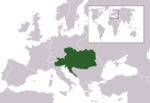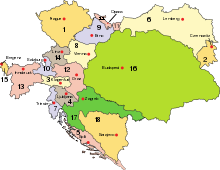- March of Moravia
-
The March or Margraviate of Moravia, was a marcher state, sometimes de facto independent and varyingly within the power of the Duchy, later Kingdom of Bohemia. It comprised the region called Moravia within the modern Czech Republic.
Contents
History
See also: MoraviaThe march was originally established, like its fellow marches — Austria, Styria, Carniola, and Carinthia — in the first half of the 10th century on land that had formerly been part of Great Moravia, a Slav state which succumbed to the Magyar incursions in the early 10th century.
Between Poland and Bohemia
After King Otto I of Germany allied with the Přemyslid duke Boleslaus I of Bohemia had defeated the Magyars at the 955 Battle of Lechfeld, Boleslaus received Moravia.[1] In 999 the Polish Duke Bolesław I Chrobry conquered Moravia and incorporated it into his reign until in 1019 or 1029[2] the Bohemian prince Bretislaus Přemysl recaptured it.
Part of Bohemian Principality
Upon his father's death in 1035, Bretislaus also became the ruler of Bohemia. In 1054, Bretislaus decreed that the Bohemian and Moravian lands would be inherited together by agnatic seniority, although he also provided that his younger sons should govern parts of Moravia as vassals to his oldest son. After that date, the march of Moravia was a Bohemian possession bestowed as a quasi-independent appanage on the younger sons of the Bohemian sovereigns. This appanage was usually held by dukes. Because, of course, there were multiple younger sons at any given moment, the Moravia was usually divided into 3 (varyingly) independent duchies/marches (úděly in Czech): Brno, Olomouc and Znojmo.
Establishing the Margraviate
In 1182 Emperor Frederick I Barbarossa intervened in Bohemian affairs to prevent any succession disputed by elevating Duke of Znojmo Conrad III Otto to the dignity of a margrave. This status was short-lived: in 1197, Duke Vladislaus III of Bohemia resolved the succession dispute between him and his brother Ottokar by abdicating from the Bohemian throne and accepting the margraviate of Moravia as a Bohemian vassal. It remained a Bohemian land (later, from 1348 onward, a land of the Bohemian Crown) after Ottokar had received the hereditary royal title by Philip of Swabia and his status acknowledged by the 1212 Golden Bull of Sicily. When Ottokar's grandson King Ottokar II of Bohemia was defeated at the 1278 Battle on the Marchfeld, his opponent King Rudolf I of Germany seized Moravia, but again granted it to Ottokar's II son and successor Wenceslaus II five years later.
Habsburg rule
With the accession of Archduke Ferdinand I of Austria to the Bohemian throne in 1526, the Margraviate of Moravia became a constituent part of the Habsburg Monarchy.
In 1608 the Bohemian and the Moravian rule were separated a last time, when the Moravian estates supported Matthias of Habsburg against his brother Emperor Rudolf II. Since Rudolf had to cede the Bohemian throne to Matthias in 1611, Moravia was directly ruled by the Habsburgs from Vienna at that time who held the title Margrave of Moravia.
In 1804 the margraviate became a province of the Austrian Empire and in 1867 a crown land of the Cisleithanian part of Austria–Hungary.
Administration
In 1348 Emperor Charles IV had begun to divide the Moravian margraviate into several kraje (lands):
From 1850 the Province of Moravia was further divided in 32 political districts (okres).
Margraves
- Conrad II, Duke of Bohemia 1182-1191
- Vladislaus III, Duke of Bohemia 1197-1222
- Vladislav II 1223-1227
- Přemysl 1227-1239
- Vladislav III 1239-1247
- Ottokar II of Bohemia 1247-1278
- Wenceslaus II of Bohemia 1283-1305
- Wenceslaus III of Bohemia 1305-1306
- Rudolf I of Bohemia 1306-1307
- Henry of Bohemia 1307-1310
- John of Bohemia 1310-1333
- Charles IV, Holy Roman Emperor 1333-1349
- John Henry 1349-1375
- John Sobieslaus 1375-1394
- Jobst of Moravia 1375-1411
- Prokop of Moravia 1375-1405
- Sigismund, Holy Roman Emperor 1419-1423
House of Habsburg
- Albert II of Germany 1423-1439
- Ladislaus the Posthumous 1440-1457
Podiebrad family
- George of Poděbrady 1458-1468
Hunyadi family
- Matthias Corvinus 1468-1490
- Vladislaus II of Bohemia and Hungary 1490-1516
- Louis II of Hungary 1516-1526
House of Habsburg
- Ferdinand I, Holy Roman Emperor 1527-1564
- Maximilian II, Holy Roman Emperor 1564-1576
- Rudolph II, Holy Roman Emperor 1576-1608
- Matthias, Holy Roman Emperor 1608-1617
From 1611, the Margraviate of Moravia and the Kingdom and Bohemia were ruled in union, see List of rulers of Bohemia.
Notes
- ^
 "Moravia". Catholic Encyclopedia. New York: Robert Appleton Company. 1913.
"Moravia". Catholic Encyclopedia. New York: Robert Appleton Company. 1913. - ^ Exact date is not known; Czech historians receive earlier, Polish, German and Slovak later year
References
- Semple, Ellen Churchill. "The Barrier Boundary of the Mediterranean Basin and Its Northern Breaches as Factors in History." Annals of the Association of American Geographers, Vol. 5. (1915), pp 27–59.
- Foundation for Medieval Genealogy: Moravia.
Provinces of the Austrian Empire Kingdom of Bohemia · Kingdom of Hungary · Kingdom of Illyria · Kingdom of Dalmatia · Kingdom of Croatia-Slavonia · Kingdom of Galicia and Lodomeria · Kingdom of Lombardy and Venetia · Archduchy of Austria · Duchy of Carinthia · Duchy of Carniola · Duchy of Salzburg · Duchy of Upper and Lower Silesia · Duchy of Styria · Duchy of Bukovina · Voivodeship of Serbia and Banat of Temeschwar · Grand Principality of Transylvania · Margraviate of Moravia · Princely County of Tyrol with Vorarlberg · Austrian Littoral (Princely County of Gorizia and Gradisca · Margravate of Istria · Imperial Free City of Trieste) · Military Frontier
 Categories:
Categories:- Holy Roman Empire
- Moravia
- Bohemia
- Historical regions in the Czech Republic
- States and territories established in 1182
- Former Slavic countries
Wikimedia Foundation. 2010.


